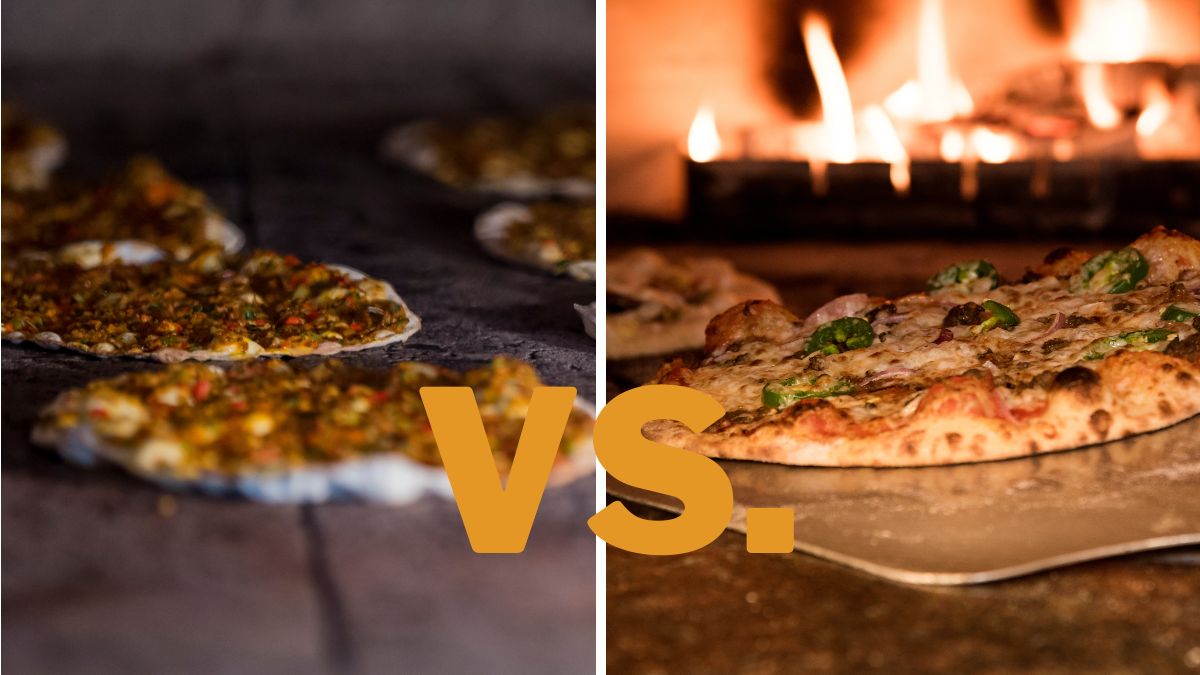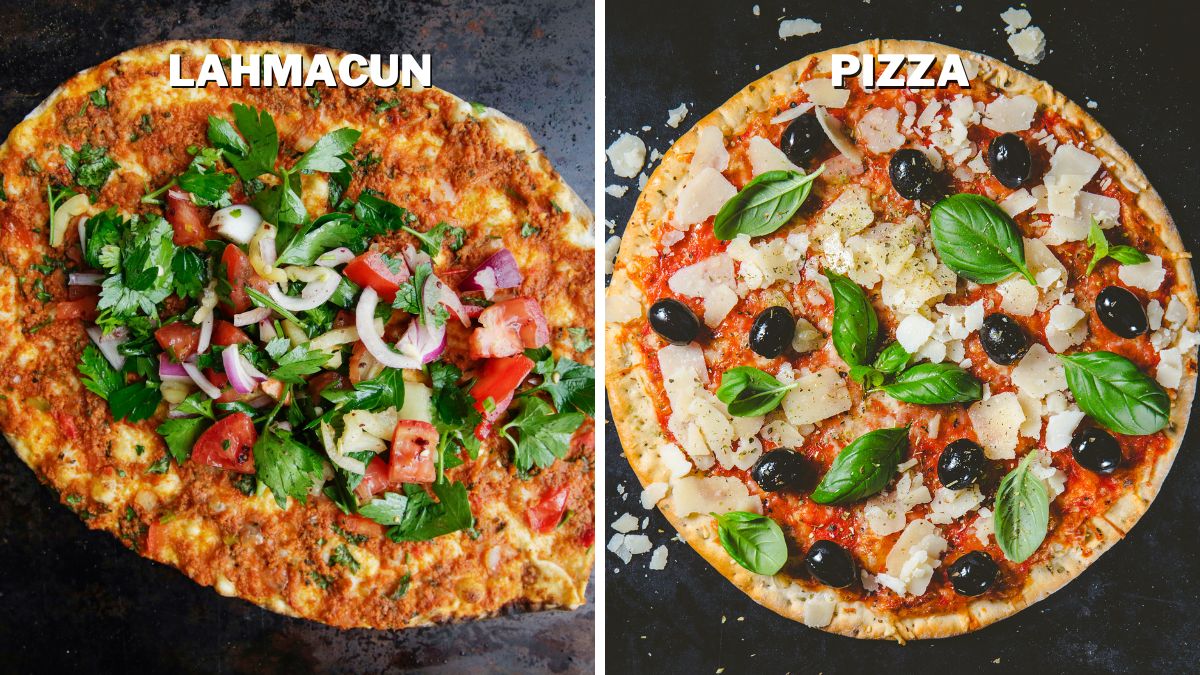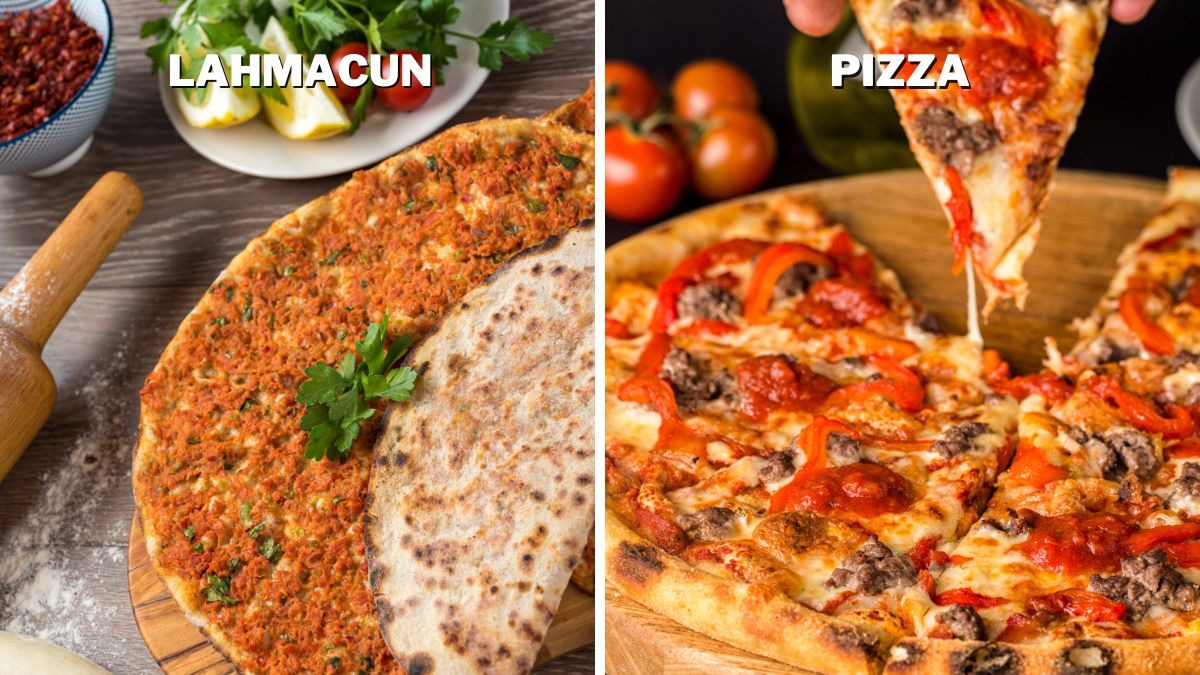Lahmacun vs. Pizza: Differences Explained

As much as I love pizza, mixing things up and trying something new from time to time is nice. Lahmacun, a Turkish dish that is also known as Turkish pizza, is perfect for when you’re craving something different but comforting at the same time. So, what are the differences between lahmacun and pizza?
While pizza comes from Italy, lahmacun was invented in the Middle East. Pizza has a thick dough, while lahmacun’s dough is thinner, and it features less versatility in topping ingredients. Thanks to special herbs, lahmacun is slightly spicier than pizza, but the latter remains more popular worldwide.
From dough to toppings and more, I’ll describe the similarities and differences between these two great dishes and, in the process, help you decide which one you should order next time!
Are Lahmacun and Pizza the Same Dish?
I often get asked about the differences between lahmacun and pizza, so I set out to answer all of your questions about this flavorful dish.
The two dishes are anything but the same dish. Even though they are similar in some aspects, the differences are apparent, even at first sight. This means that you cannot really mistake one for another.
Still, no matter which one you choose, it’s sure to be the delicious centerpiece of your next meal experience. So, grab a slice (or lahmacun) and enjoy!
What Are the Differences Between Lahmacun and Pizza?
At first glance, it might be easy to think that lahmacun and pizza are one and the same. After all, they’re both savory dishes that feature dough, toppings, and lots of flavourful spices. However, some key differences between these two dishes make them unique.
To start with, let’s look at origins. While pizza is a staple of Italian cuisine, lahmacun is typical in Middle Eastern countries like Turkey and Lebanon. Secondly, their doughs vary slightly.
When it comes to ingredients and preparation, lahmacun tends to have fewer layers than a pizza. The toppings also differ a great deal. Furthermore, the two also differ in appearance and taste, lahmacun is definitely thinner, and it tastes differently, usually, it’s a bit on the spicy side.
Lastly, there’s the difference in the way you serve them up for dinner. Even though both are often served with salads or yogurt dips that help tone down their flavors upon request, they are not served in the same way. So, let’s look at these differences in more detail.
Origin
Where did lahmacun and pizza come from? The answer isn’t an easy one.
Surprisingly, these two dishes share a common origin – the traditional Italian pizza. Centuries ago, when Italian immigrants began settling in the Middle East region, they brought with them the recipe for this delicious, savory dish. Over time, as the regional cuisine evolved, so did their interpretation of it: thus, lahmacun was born.
While the origin of lahmacun and pizza is shared, their specific ingredients and preparation methods have evolved to create two unique dishes. Understanding these differences can help you determine which one you’d prefer when dining out or cooking at home.
Dough Differences
The dough probably takes the cake when it comes to lahmacun and pizza differences. The dough for lahmacun is much thinner than the dough used for pizza, and the ingredients of these two doughs are actually quite different.
The dough for lahmacun is made from a combination of wheat flour, water, and maybe some additions like yogurt or milk, whereas the dough for pizza contains many more ingredients – like salt, oil, and yeast – that make up a more flavorful and sturdier crust.
The flavorings for lahmacun dough are also much milder than those included in pizza dough, usually just a lightly-seasoned mixture of herbs like paprika, cumin, and sumac.
Ingredients and Preparation
When it comes to the details of the ingredients and preparation of lahmacun and pizza, there are many differences.
Lahmacun is rolled out by hand on a round flat surface, while the pizza dough is spread by hand or machine over a circular pan.
Besides the dough consistency, other ingredients vary between lahmacun and pizza.
The topping for lahmacun usually consists of herbs such as parsley, red pepper paste, tomatoes, onions, and minced meat like ground beef or lamb. While adding any cheese to a lahmacun topping is not mandatory, feta cheese or garlic yogurt is often included for additional flavor.
On the other hand, pizzas come with more diverse toppings – vegetables like mushrooms, bell peppers, and olives; different types of cheeses like mozzarella; processed meats like pepperoni and sausage; seafood like anchovies – the list goes on and I bet you’ve made some experiments yourself!
The way these dishes are cooked has some similarities. Both are cooked in an oven at high temperatures until they become golden brown. However, lahmacun can be cooked on an open fire or in special ovens on wood or charcoal-burning grills, giving it a unique taste. On the other hand, pizza tends to be roasted in large ovens only because it needs high temperatures to cook correctly. After removing them from the oven, they can be served with extra garnishes such as lemon juice or spices like chili flakes or oregano.
Topping Variety

Regarding topping variety, both dishes have certain things in common. Many of the popular toppings you’d find on either dish overlap: ground meat, onions, peppers, olives, mushrooms, and herbs are common on both. Where they differ is in a few key areas.
Toppings found specifically on lahmacun tend to be more traditional Middle Eastern ingredients. Lamb is a popular choice for lahmacun; minced beef is also sometimes used.
It’s then mixed with onions and spices like cumin, paprika, and allspice, creating a spicy topping that really packs a flavorful punch. Tomatoes or tomato sauce may also be used to accompany the meat mixture to add juiciness.
Pizza toppings are more variable and open to different interpretations. Classic Italian ingredients like mozzarella cheese, Parmesan cheese, and pepperoni are common alongside Mediterranean specialties like anchovies and capers or Mediterranean vegetables such as artichokes or eggplant. The possibilities are endless!
It’s clear that when it comes to toppings, both lahmacun and pizza can offer a range of tasty options suitable for different palates – but those flavors can certainly differ from one another significantly between the two dishes!
Appearance and Taste
One key difference between lahmacun and pizza is the visual appearance of each dish and the taste that comes with it.
Pizza is often known for its thick dough, cheese topping, and bright tomato sauce. In contrast, lahmacun has a thin, almost crêpe-like base made from flour and yogurt and is often served rolled up with salad onions. The topping ingredients for lahmacun are minced meat mixed with tomatoes, peppers, and a mix of spices, giving them a distinct reddish-brown color.
Pizza has a soft yet chewy base, combined with the richness of melted cheese and acidic tomatoes, giving it an overall savory flavor. Lahmacun, conversely, has a crispier texture than pizza due to its thin dough base.
As for its taste, lahmacun is much spicier than pizza as it can be flavored with Middle Eastern herbs such as cumin, sumac, and oregano to give it an aromatic undertone.
Serving Style and Side Dishes

When it comes to the way in which lahmacun and pizza are served, there definitely is a difference. While lahmacun tends to be served as a wrap, pizza is typically presented as a large circular pie, with each slice cut and individually served.
The size of the lahmacun makes it more suitable for eating on the go, whereas pizza is more likely to be enjoyed as part of a sit-down meal or gathering.
Regarding side dishes and accompaniments, lahmacun may be served with chopped vegetables, such as tomatoes and onions, and it can even include pickled vegetables for an extra crunchy texture. Pizzas are usually eaten as a complete dish in itself and are rarely accompanied by anything else.
Another way to spot the difference between lahmacun and pizza is that they tend to be enjoyed differently – lahmacun is often shared between several people, while pizza is usually consumed on one’s own. So next time you come across either of these dishes while out and about, remember the subtle yet meaningful differences between them!
Popularity
It’s clear that both lahmacun and pizza are popular dishes. But when it comes to popularity, the clear winner is pizza. The global pizza industry is worth billions of dollars and continues to grow year after year.
But don’t write off lahmacun just yet – this dish has gained recognition outside of its native Turkey. Lahmacun has been spotted on the menus of American fast-food chains and gourmet restaurants across Europe and other parts of the world. In some cities across the Middle East, it is even given away free with certain meals!
Still, pizza remains one of the top comfort foods worldwide – after all, who doesn’t love a slice? I know I do!
Unsurprisingly, pizzas come in different shapes for different regions – from deep-dish pizzas in Chicago to New York-style pies. With endless variety and toppings available, people can always find what they’re looking for with a slice of pizza.
